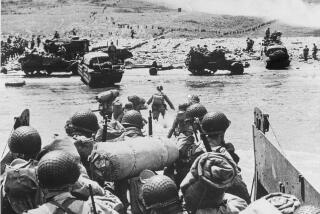Irving P. Krick; Pioneering Meteorologist, Rainmaker
- Share via
Irving P. Krick, pioneering meteorologist, rainmaker and a member of the team that made the crucial weather forecast for the massive D-day invasion of Normandy in World War II, has died. He was 89.
Krick, who established a meteorology department at Caltech, died Thursday at his home in Pasadena, said Francis H. Kingston of Strategic Weather Services.
As an Army colonel, Krick left Caltech in the early days of the war to head the Weather Information Section of the U.S. Strategic Air Forces in Europe. His forecasts were necessary to enhance the success of Allied bombing runs.
Krick and five others--two from the British Air Ministry, two from the British Admiralty and Lt. Col. Ben Holzman, Krick’s associate at Caltech--were assigned to find Allied commander Gen. Dwight D. Eisenhower a three-day time window of relatively calm weather for the invasion.
Worried by unseasonal storms lashing the Northern Atlantic, the forecasters finally made the call: “The only three days this month that you can do it will be June 6, 7 and 8.” Eisenhower nodded, and June 6 was inscribed in world history as D-day.
Which one of the six men actually risked the precise prediction has become as controversial as Krick’s entire career of making long-range forecasts and seeding clouds to make rain. Many credit one of the Britons. But Victor Boesen, who wrote the 1978 book “Storm: Irving Krick vs. the U.S. Weather Bureaucracy,” flatly concluded: “Ike’s decision to invade was based on Krick’s forecast.”
Even before the U.S. entered the war, Krick observed that Germany was succeeding against European adversaries because of its ability to forecast “bombing and tank” weather accurately.
Born in San Francisco, Krick was a child prodigy concert pianist, performing around the Bay Area in his early teens. He earned a bachelor’s degree in physics at UC Berkeley and then went to Caltech for one of the nation’s first master’s and doctoral degrees in meteorology.
Urged by the school’s officials, in 1934 Krick established a meteorology department as a branch of Caltech’s aeronautics department.
Two years later, he set up one of the first private meteorological consulting firms, and the Motion Picture Producers Assn. was among his first clients. Krick was hired to predict which night’s weather would be right for the burning of Atlanta in “Gone With the Wind.”
Always a maverick, Krick based his forecasts--for weeks, months or even years--on historic weather patterns. He was one of the first meteorologists to use computers in making long-range predictions. The National Weather Service and most of the 100 or so weather consulting companies base forecasts on current weather activity and doubt that reliable long-range forecasts are scientifically possible.
Krick even condensed data from 55 years of past weather activity into a simplified slide-rule gadget designed to be sold for home weather predicting.
In 1948, Krick left Caltech to devote full time to his consulting firm, Irving P. Krick Associates. He sold the company to Strategic Weather Services in 1990, remaining involved as chairman emeritus.
“Weather is my life,” Krick told The Times in 1985. “If I retired, I’d be dead the next day.”
His clients, from 33 states and 14 foreign nations, ranged from his friend Walt Disney to the Mexican Department of Agriculture to the inaugural committees of every U.S. president from Eisenhower to Bill Clinton.
After experiments here and in Arizona with dry ice and silver iodide in the late 1940s, Krick became the first to offer commercial cloud-seeding to increase rain. The procedure was certified as effective in 1957 by the President’s Committee on Weather Modification.
Krick is survived by his wife, Marie; a daughter, Marilyn Lunde of Palo Alto, and a son, Irving P. Krick II of Battle Creek, Mich.






